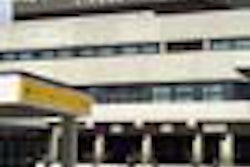The U.S. Air Force is poised to become a bigger force in radiology training, with a program for new recruits that will fund radiology residencies at civilian centers.
Would-be radiologists seeking a residency have until September 14 to apply to the Air Force's pilot program. Five or more successful applicants will have their positions funded at whatever institution will take them -- enabling a few radiology programs to supplement their ranks for free.
"The institution pays nothing," says Dayan Geiger, deputy chief of the Air Force physician education branch. "It’s a win-win situation."
Specifically, the Air Force will cover all costs associated with the resident’s training except for liability. The selected residents receive their training and salary, plus military entitlements such as health coverage, housing allowance, and cost-of-living allowance. In exchange, they must repay the Air Force with up to five years of active duty service -- one year for each year of their sponsored training.
Joining the military to get a free medical education is a longstanding tradition, of course. But even with its existing programs, the Air Force still has a shortage of radiologists because those specialists aren’t staying beyond their minimum service commitment.
"Because the salaries are so great in the civilian world, it’s very hard to keep people past that obligation," said Dr. Gary L.George, radiology consultant to the Air Force surgeon general. The Air Force is currently down to 118 from 149 radiologists, and expected departures will take that number to 70 by 2003, George said. Even with efficiencies gained through the ongoing installation of PACS at Air Force facilities worldwide, the service will need around 125 radiologists, George said.
The Air Force’s new program is unique because it is the first to fund "unmatched" residents who also haven’t previously joined the military, said Dr. Mark T. Nadeau, chief of the service’s physician education branch. The Air Force also needs to attract radiologists trained at civilian facilities because it can train fewer than 10 radiologists per year at its own residency programs, Nadeau said.
The trainees accepted into the new program will have the burden and blessing of finding themselves a spot at a civilian institution. That means they could very well end up in the nation’s best-regarded radiology programs, assuming those institutions are amenable to taking on a free resident. "This is an opportunity for people to get into very good programs," said George.
Given the perpetual budget crunches in healthcare delivery, it seems likely that many institutions would welcome another no-cost resident. In fact, about 20 institutions have already told George they would welcome Air Force-sponsored applicants.
The Air Force hasn’t limited the number of sponsorships that can go to any given institution. However, the institutions must petition the Accreditation Council for Graduate Medical Education (ACGME) to have "extra" residency slots that weren’t among the 900 or so offered in the most recent National Medical Residency Program (NMRP) match.
George expects the Air Force could have many applicants for its residencies, given that a reported 300 qualified participants failed to obtain a radiology slot in the March NMRP match. But he doesn’t see the Air Force becoming a huge force in radiology education because the service can afford to fund only a finite number of residencies.
"I can’t see this program growing past about 20 people per year," George said. On the other hand, "If the Navy and Army also did this, then we’re talking about 60 or 70 [newly funded residencies per year.]"
The Air Force program is open to fourth-year medical students, interns and other graduates of U.S. medical schools. Successful applicants must be OK’d for active duty military service by an Air Force accession board that meets in October; next they apply to the military Graduate Medical Education selection board that meets in December.
The GME board is expected to announce its selections by the end of December 2001. Those chosen can then contact civilian radiology programs about coming on board as an "extra" resident. The sponsored residencies will begin in July 2002.
By Tracie L. ThompsonAuntMinnie.com contributing writer
August 24, 2001
Interested applicants should contact their local Air Force recruiter after preparing all of the materials requested in an application form found on the Internet. For more information and assistance, contact Geiger or Nadeau in the education office at Randolph Air Force Base in Texas, telephone number (800) 531-5800 or (210) 565-2638.
Copyright © 2001 AuntMinnie.com

















